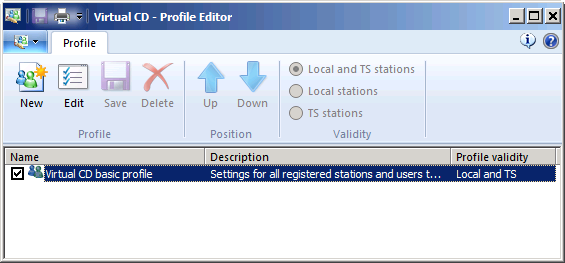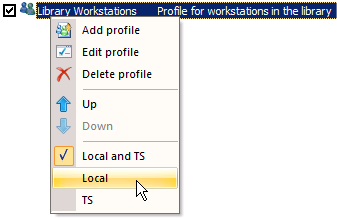In a network with a large number of Virtual CD client stations, it may be useful to define settings that are applied to certain clients or groups of clients; for example, to specify which functions may be used and which security settings are active. You can do this by creating and assigning profiles. Profiles define "conditions of use" for stations logged on to Virtual CD NMS.
Profiles are defined and edited using the Profile Editor. The Profile Editor is opened from the Ribbon in NMS Administration as follows: On the Virtual CD NMS tab, in the Profiles section, click on Edit. This opens the Profile Editor, with the main window showing all of the existing profiles. The first time you open the Profile Editor, only the default profile is shown: "Virtual CD basic profile." Every Virtual CD client station is assigned a profile when it logs on to NMS. If you have not specified a profile for a particular client, that client continues to use the Virtual CD basic profile:

|
Profiles cannot be defined for Virtual CD FS, to prevent the risk of allowing non-administrative users to access drives on the file server. In conjunction with Virtual CD TS, on the other hand, profiles can be used to their fullest extent. |
The first time you run Virtual CD NMS, the basic profile does not impose any limitations on users.
When you change a profile, the new settings are active only after:
| • | the changes have been saved, and |
| • | a new session is opened. |
|
It is a good idea to back up your profile data regularly so that you always have a recent version available in case of emergencies. The definition of a profile is stored in a PRF file that has the same name as the profile. Profiles are stored in the "Profiles" subdirectory of the Virtual CD NMS data directory. |
The Profile Editor distinguishes two types of profile:
| • | Virtual CD basic profile. Default profile; cannot be deleted; is automatically applied to all users for whom no profile has been explicitly assigned. |
| • | User profiles. Can be assigned to station groups. Every client station must be assigned a profile so that user settings can be loaded. If no user profile is specified, the settings defined in the "basic profile" are applied. |
Validity of profile:
When you create a profile, you are prompted to define its area of validity. A local profile is applicable only to stations that are registered locally; a TS profile applies for stations that register in NMS during a terminal server session. You can also define the area of validity at a later date, in the profile's shortcut menu:

|
The area of validity for the basic profile is "Local and TS;" this cannot be modified. This ensures that there is always at least one valid profile available. |
Local and TS. The profile applies for both local stations and stations in Terminal Server sessions.
Local. This profile is assigned only to users that register locally; i.e., not in a terminal server session.
TS. This profile is assigned only to users in Terminal Servers sessions.
Whether a station is registered locally or in a terminal server session can be an important difference for certain administrative decisions. For example, you might want to give local users broader permissions, allowing them capabilities such as creating virtual CDs or locking drives, while preventing users in terminal server sessions from using these features.